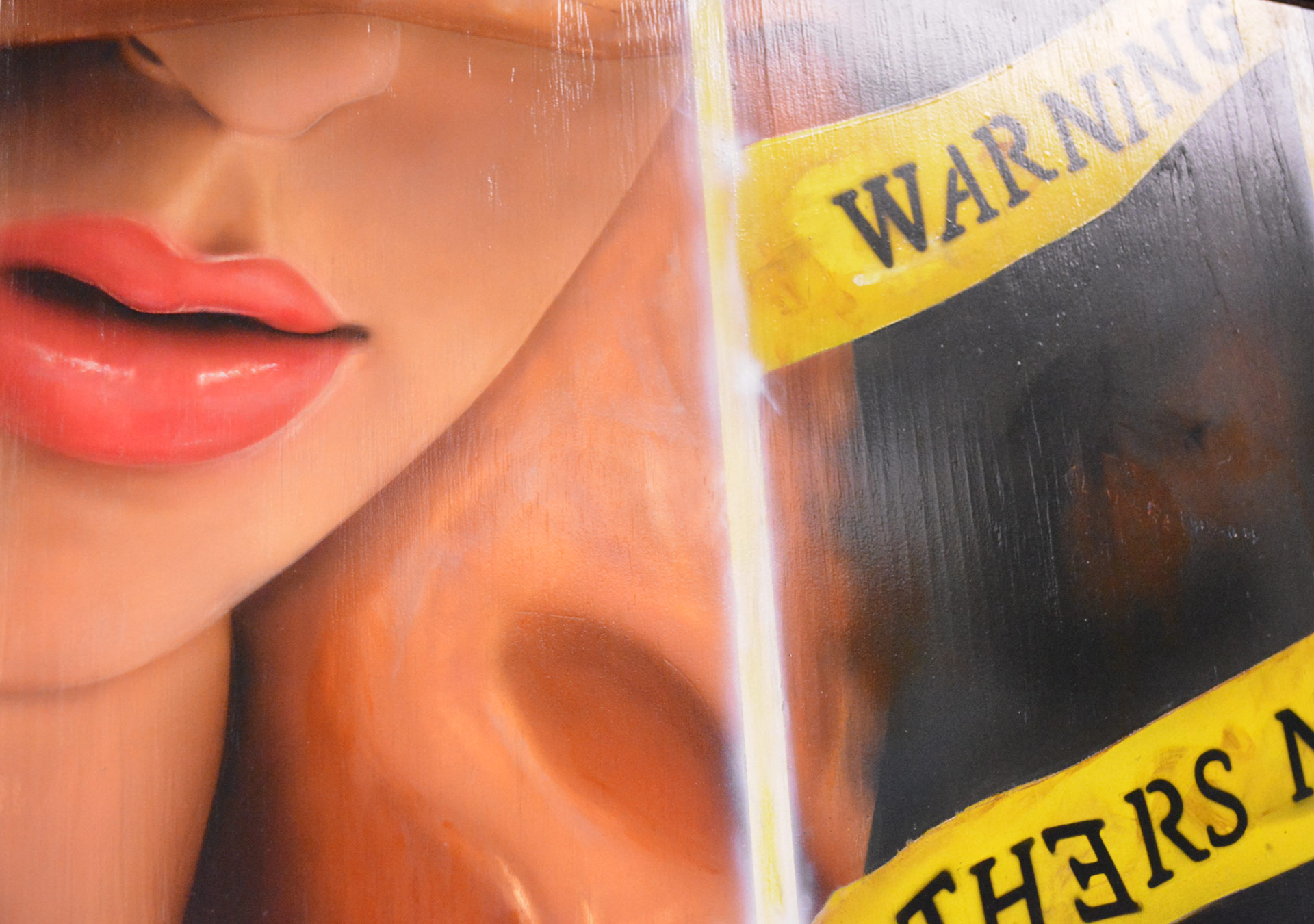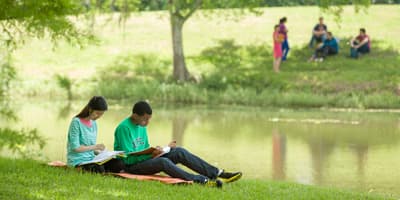Incarcerated student’s gift of art expresses introspection and gratitude for UHCL
education
January 22, 2018 | UHCL Staff

It’s not unusual for students to give their teacher or professor a gift to express
their appreciation for what they’ve learned, or for the support they’ve received in
a particular class. When Associate Professor of Humanities Shreerekha Subramanian
saw her student’s mother appear in her office to present her with a very large painting
on behalf of her son, it was much more than a token gift of thanks for an enjoyable
class.
In the 10 years that Subramanian has been on the faculty at University of Houston-Clear
Lake, she has been teaching undergraduate humanities courses at the W.F. Ramsey Unit,
a Texas Department of Criminal Justice prison located in Rosharon, which is where
her artistic student is currently serving his sentence.
“UH-Clear Lake has had this program for inmates since 1974, when the university first
opened,” Subramanian said. “Inmates are able to get an undergraduate degree in behavioral
science or a master’s degree in humanities or literature. Students in the Ramsey program
have been very successful and hardworking students who are sincere about improving
their lives and getting an education.”
Faculty from the College of Human Sciences and Humanities, especially full-time faculty
from the Department of Liberal Arts that Subramanian currently chairs, have been teaching
for this program since the start of the university. Many of our charter faculty, such
as Gretchen Mieszkowski, John Gorman, and Bruce Palmer as well as current faculty
in literature and humanities programs teach at the Ramsey Unit. The Program, Academics
for Offenders, housed in the College of Human Sciences and Humanities, is Texas Department
of Corrections’ Program for Incarcerated Students.
“The success of the program is a direct result of the dedication of the faculty, both
full-time and adjunct, who have contributed to the TDC program from its inception,”
said William Powers, UHCL director of TDCJ and adjunct instructor for graduate and
undergraduate programs at TDCJ’s Ramsey Unit. “This dedication has enabled us to award
over 600 degrees to students within the TDCJ. The vast majority of those students
do not recidivate, but rather pursue other advanced degrees and secure meaningful,
relevant career opportunities.”
The artist who painted the gift for Subramanian finished his undergraduate degree
in Behavioral Sciences and was 2016 valedictorian for his Ramsey Unit class. “He wished
to share with me what he learned from my classes through this art,” said Subramanian.
The mixed-media acrylic, airbrush, wood putty and pen image, which the artist painted
on recycled ¾ inch thick plywood because he has no access to canvas, depicts his newly-gained
perspective on the world since he’s been working on his degree.
In his artist’s statement, the artist wrote that he wished to express a sense of giving
value to those who felt they had been rendered worthless by society. Although the
artist is white, he wrote that he focused his brush on the face of a young black man
to address issues of power and disenfranchisement that plague our society, at present.
The yellow police tape symbolizes the very real and sometimes invisible borders that
are set in our culture that keep people in their own communities, afraid or unable
to cross over and interact with others. The words, “Warning, No Crossing” indicates
his sense of feeling “crossed out,” or invisible. On the top left is a partially covered
woman whom the artist places as a reminder of the objectification of women; according
to him, she is the Everywoman who is on the other side of the border, veiled and misunderstood,
and also unable to cross the border toward self-representation.
“He writes that in this painting, he wishes to cross lines and see perspectives of
others rather than focus on stereotypes,” Subramanian said. “He has learned that it’s
much better to cross boundaries and enter into dialogue.”
The artist, who titles the painting “Who is i? Who is I?” said, “I would like to
convey the fact that there are people desiring and trying to escape poverty and lack
of opportunities in their own homes/neighborhoods. Yet walls exist impeding their
progress for various reasons, such as the color of their skin, the religion they are
born into, or their lack of education, and access to power.”
Subramanian said she believed her student had put over 100 hours of work into the
painting. “It’s quite an impressive-sized work, and it’s currently hanging in (Dean
of Human Sciences and Humanities) Rick Short’s office.”
Short, who is looking for the best space to hang the painting in the College of Human
Sciences and Humanities office suite, expressed great optimism for the Ramsey Unit
program. “It’s been extremely successful, and it’s important to note that we are not
providing any special privileges at all to the inmates,” he said.
“It’s a misconception that resources are allocated to mitigate punishment or perhaps
even shorten sentences. Inmates are required to pay the same tuition that any student
would pay. Obviously, inmates cannot park or use the library on campus, so they do
not pay those fees, but all other requirements are exactly the same,” Short said.
Short added that the curriculum expectations were identical for inmates as for any
UHCL student. “It’s hard work. There is nothing ‘watered down’ about the coursework,”
he said. “Education is the single most effective way to help an inmate lead a productive
life outside of prison. The rate of recidivism among inmates with an education is
so much lower, which benefits everyone.”
Prison education reduces recidivism by more than 40 percent, the global policy think
tank RAND Corporation reported in 2013.
Crime is expensive, explained Short. Not only are innocent citizens hurt by the destruction
or loss of their property or personal injury, but it also costs massive amounts of
money for the state to keep inmates incarcerated. “There’s simply no better way to
keep them from returning to prison than to educate them,” he said. “The state won’t
have to pay huge sums to keep these people off the streets. It’s the right answer.”
If an inmate completes coursework through UHCL while incarcerated, said Short, he
will not exit prison with technical skills. “We have a different view on prison education,”
he said. “We want them to become ethical beings and critical thinkers who have acquired
an internal compass or standard of behavior so they can judge their decisions and
behave logically and ethically. And it works.”
The coursework and the interaction with the professors provides inmates a way to think,
introspection about what they’ve done, and are taught to evaluate what is truth and
what is good. “They learn to make different decisions,” Short said.
“We are not saying that all inmates are ready to move into society because they have
been educated, but certainly the statistics show that recidivism rates are much lower.
Our objective is to help all citizens become educated, and that’s true for inmates
as well.”
Subramanian said that she was deeply moved by the painting and by her student’s efforts
to demonstrate his gratitude to the university for the education he had received.
“It’s rare for a student to turn back to say thank you,” she said. “But then, to turn
back with this dedicated piece of art work to demonstrate all the ineffable things
that have been learned, it is really a testament to all the positive things that are
going on in the Ramsey program.”
About the Author:
Recent entries by
October 18 2022
Better technology transforms campus safety: Police Chief demonstrates SafeZone to students
October 14 2022
Student's skill with drones takes chicken turtle research to new heights
October 11 2022
Planting event to help UHCL restore native plants to campus, support environmental sustainability







